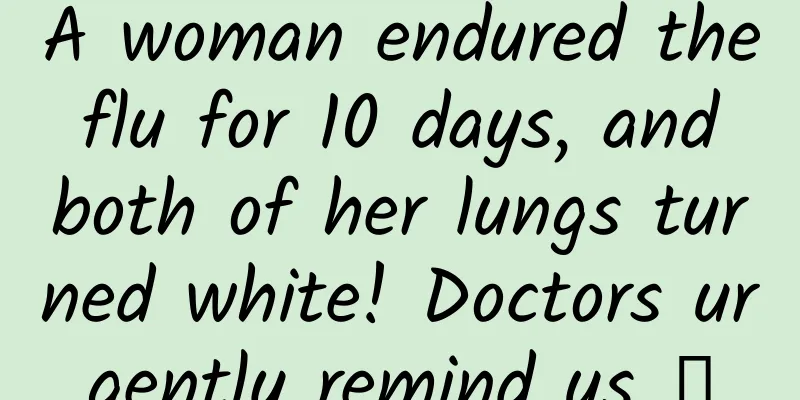A woman endured the flu for 10 days, and both of her lungs turned white! Doctors urgently remind us →

|
Recently, a 51-year-old woman became a hot topic because of flu-induced white lung. Not long ago, a 30-year-old man went to the doctor because of "flu fever for 4 days". The anti-flu treatment was ineffective, and his condition continued to worsen and he was admitted to the ICU. Why is the flu so serious? Can young people who fight it die? Image source: Related Weibo screenshots In fact, we really can't underestimate influenza. The Chinese translation of influenza (Influenza) can mislead the public, making people think that it is the common cold (Common Cold) that is spreading. According to WHO estimates, influenza can cause 3 million to 5 million severe illnesses and 290,000 to 650,000 respiratory disease-related deaths worldwide each year. A global study estimated the mortality rate in 33 countries from 1999 to 2015 and estimated the average annual influenza-related mortality rate to be as follows: What are the risks of fighting the flu head-on? Clinically, people under 5 years old, 65 years old or older (some guidelines limit it to over 50 years old), pregnant women, people within 2 weeks of giving birth, and people with chronic underlying diseases are listed as high-risk groups for complications. The risk of complications from influenza is low in healthy young and middle-aged people, but the risk cannot be ignored. Source: References According to statistical research, the main complications of influenza are as follows: 1. Pneumonia It is the most common complication of influenza, with typical symptoms of cough with dyspnea, tachypnea (>24 breaths/minute), hypoxia and fever (>3 days). Types of pneumonia include: Primary influenza virus pneumonia: high fever persists 3 to 5 days after the onset of influenza, as well as the above pneumonia symptoms. It is usually very serious and may progress quickly. Without active intervention, it may be life-threatening, especially for people with lung or cardiovascular diseases. Secondary bacterial pneumonia: After the flu symptoms have improved (including fever subsides), fever and coughing up purulent sputum reappear. Usually occurs a few days after the flu (7-14 days), the most common, accounting for about 1/3 of severe flu, and secondary Staphylococcus aureus pneumonia is often critical. Mixed bacterial and viral pneumonia: Referring to the above two, it can manifest as gradually worsening symptoms, or it can manifest as a brief improvement followed by worsening. 2. Heart complications Myocardial ischemia, myocardial infarction, and heart failure account for about 12% of influenza in adults, but influenza myocarditis and pericarditis are rare. 3. Central nervous system complications Seizures are more common in children and patients with epilepsy, influenza-associated encephalopathy is more common in children, and influenza-induced encephalitis, cerebrovascular accidents, acute disseminated encephalomyelitis, and Guillain-Barré syndrome in adults are generally uncommon. 4. Musculoskeletal complications Severe myositis and rhabdomyolysis (extreme myalgia, weakness, dark urine) are more common in children. Although myalgia is a prominent feature of influenza, true myositis is uncommon. 5. Toxic shock During recent influenza A and B outbreaks, toxic shock-like syndromes have occurred in previously healthy children and adults, often associated with secondary toxigenic staphylococcal infections. 6. Co-infection These include pneumonia (other viruses, bacteria, fungi), bacteremia, meningitis, and aspergillosis. Patients with influenza who have a fever for more than 3 to 5 days, who have a fever again after the fever subsides, or whose symptoms continue to worsen after 3 to 5 days of illness should be alert. What is the difference between the flu and the common cold? 1. Common cold symptoms Typical common colds usually present with obvious nasal discharge and nasal congestion. Other common symptoms include dry throat, itching or pain, cough and discomfort. Adults rarely have fever or low-grade fever due to colds. Cough is more common and often occurs after nasal congestion and nasal discharge. Nasal discharge may be clear or purulent (not necessarily a bacterial infection). 2. Flu symptoms The symptoms of influenza vary from person to person. Mild symptoms are similar to those of a cold, while severe symptoms may cause the complications mentioned above. Typical influenza without complications has the following characteristics: ① If symptoms appear suddenly, a review of the cross-infection history may reveal close contact with a cold or flu patient within the previous 1 to 4 days. ②Sudden onset of clinical manifestations, including: Fever: Low to high fever, up to 40°C, usually subsides on the 2nd and 3rd day dry cough Myalgia Malaise, general fatigue Chills (fear of cold, shivering) Sore throat Headache Nausea, vomiting and diarrhea in adults Nasal congestion, runny nose Eye pain The discomfort caused by systemic symptoms of influenza (myalgia, headache, malaise, weakness, nausea, etc.) is more obvious than respiratory symptoms (cough, nasal congestion, runny nose, sore throat); while the common cold is mainly characterized by respiratory symptoms. What should I do if I get the flu? A. Self-judgment For healthy young people (15 to 65 years old), if there are influenza cases in their community, school, office, etc. during the influenza season, and they suddenly develop fever, cough, myalgia or weakness, influenza can be suspected clinically. Influenza testing is not needed for diagnosis at this time. Purchasing antigen home testing is also an option, but due to the sampling technology, the positive accuracy rate may not reach the expected 50% to 70%. When a clear diagnosis is needed, multiple sampling within 1 to 2 days can help improve the positive accuracy rate. In uncomplicated influenza, fever and respiratory symptoms in adults usually last about 3 days, and most will improve afterwards. Full recovery may take 10 to 14 days (older people and those with weakened immune systems may take longer to recover), and fatigue symptoms may persist for several weeks in some patients. Influenza complications, or dehydration (thirst, fatigue, less urine and yellow urine), impaired heart and lung function, or changes in mental status are usually serious illnesses and should be treated in hospital. Copyright images in the gallery. Reprinting and using them may lead to copyright disputes. B. When influenza is suspected or confirmed, active antiviral treatment is required if any of the following conditions are met: ① People at high risk of complications: For high-risk groups of influenza, antiviral treatment is recommended regardless of the severity of symptoms or whether the course of the disease exceeds 2 days. ② Contact with high-risk groups: For those who are not in the high-risk group but have contact with high-risk groups (such as those with children or the elderly at home), antiviral treatment is also recommended regardless of the severity of symptoms or whether the course of the disease exceeds 2 days. ③ Influenza persists or is severe: Flu-like symptoms persist for more than 3 days, or influenza complications or severe illness occur. If the illness is severe or lasts for more than 2 days, it is recommended to follow the doctor's advice and use the corresponding antiviral drugs for timely treatment. C does not belong to the above three situations. Weigh the pros and cons before taking the medicine: if the course of the disease is within 48 hours, you can communicate with the doctor to decide whether to give antiviral treatment based on your own life, work or study needs, because mild influenza can heal itself, and drugs can shorten the course of the disease, but at the same time there is an increased risk of drug resistance. If the illness has lasted for more than 48 hours and does not meet the above three conditions requiring medication, antiviral treatment is not recommended. References [1] National Immunization Program Technical Working Group, Influenza Vaccine Working Group. Technical Guidelines for Influenza Vaccination in China (2023-2024) [2]IulianoAD,RoguskiKM,ChangHH,etal.Estimates of globalseasonalinfluenza-associatedrespiratorymortality:amodellingstudy.Lancet.2018;391(10127):1285. [3]DynaMed.ClinicalPresentationofInfluenzainAdults.EBSCOInformationServices.Accessed January 14, 2024.https://www.dynamed.com/condition/clinical-presentation-of-influenza-in-adults. [4]Raphael Dolin. Seasonalinfluenzainadults:Clinicalmanifestationsanddiagnosis.UpToDate.https://www.uptodate.com/contents/seasonal-influenza-in-adults-clinical-manifestations-and-diagnosis.(AccessedonNov06,2023). [5]DanielJSexton,MicahTMcClain.Thecommoncoldinadults:Diagnosisandclinicalfeatures.UpToDate.https://www.uptodate.com/contents/the-common-cold-in-adults-diagnosis-and-clinical-features.(AccessedonOct31,2023). [6] KimonCZachary. Seasonalinfluenzainnonpregnantadults:Treatment.UpToDate.https://www.uptodate.com/contents/seasonal-influenza-in-nonpregnant-adults-treatment. (AccessedonDec13, 2023). This article is a work of Science Popularization China-Starry Sky Project Produced by: Science Popularization Department of China Association for Science and Technology Producer|China Science and Technology Press Co., Ltd., Beijing Zhongke Xinghe Culture Media Co., Ltd. Author: Fan Yunzhu, Chief Physician of Jiahui Medical Review丨Zhang Yu, Researcher, Chinese Center for Disease Control and Prevention, Doctor of Medicine |
>>: Once a jay hides its food, does it really remember it?
Recommend
Do you have promotional abilities?
There are many tasks that operations are responsi...
Nissan Leaf's autopilot turned off during demonstration, posing safety issues
Last week in Yokohama, near Tokyo, Nissan Motor C...
Sun Mingzhan: Teach you how to choose insurance step by step
Sun Mingzhan: Teach you how to choose insurance s...
Academician of the Chinese Academy of Sciences demonstrated the "Huluwa Invisibility" on site! Will science fiction become reality?
From ancient times to the present, invisibility h...
Uber admits to using anti-phishing software to evade regulators
Uber has been in the news lately: accused of stea...
How to create hot marketing activities and specific implementation plans!
In the early morning of July 27, I saw several on...
The Webb Space Telescope, which cost tens of billions of dollars and took 25 years to build, has finally been launched! How is it different from the Hubble?
The Webb Space Telescope is finally launched! It ...
A practical guide to writing copy for educational information flows to effectively increase click-through rates!
Information flow advertising copy is one of the k...
Life scene record | Why do accidents always happen in the toilet?
The bathroom at home has always been a place wher...
Five factors that affect Android app market search rankings
After every app developer completes listing on ma...
Authoritative Express丨The top ten archaeological discoveries in China in 2022 were announced
Under the supervision of the State Administration...
Lu Songsong’s blog has 100,000 visitors per day. How much money can the operating business under Songsong Brothers make in a year?
Lu Songsong is a well-known figure in our blog ci...
Probability can also deceive people. How can we make the football team's performance look better? Using Simpson's paradox
In our daily work and life, we often like to anal...
In 5 days, WeChat will ban this behavior
As a "cosmic center", WeChat has always...









